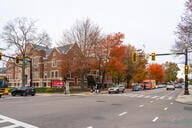You have /5 articles left.
Sign up for a free account or log in.
Almost a year and a half after Duke University’s faculty approved the first phase of development of a new campus in Kunshan, China, some professors are starting to raise objections.
At a recent academic council meeting, faculty members questioned Duke President Richard Brodhead about cost estimates, academic freedom, Internet access, and faculty involvement and buy-in. While the faculty’s questions haven’t kept the administration from moving ahead, they echo common concerns at many universities trying to open new campuses abroad.
While Duke partnered with the National University of Singapore to create a graduate medical program in Singapore in 2005, the Kunshan campus would be the university's first attempt at a comprehensive campus granting Duke degrees in another country. Duke has a partner university in the country for the Kunshan campus, but that partner will not play an active role in the academic process comparable to the NUS role in the Duke-NUS medical program. The campus would initially house a few business programs, mostly for students from China and surrounding countries. Administrators say the long-term vision for the campus is a full-fledged university with international graduate and undergraduate degree programs. The first phase of development, which extends for six years, would accommodate 700 students. The university would base further enrollment growth on the results of the first phase.
The planned campus would be a separate entity called Duke-Kunshan University, but the U.S. campus would still wield significant authority. Duke would appoint three members to the seven-member board, and the board would require a five-vote majority to pass any measure. The city of Kunshan and Duke's partner university, Wuhan University, would each fill two slots on the board. The campus would grant Duke degrees, and Duke faculty would establish the academic programs.
Those details have been clear for more than a year, but with the actual physical campus under construction and discussion about academics and finance happening more often, some faculty members say they are starting to feel out of the loop about where the campus is heading.
“There has been no genuine effort to apprise the faculty of the nature and the purpose and the ultimate ends of this project,” said Thomas Pfau, a professor of English and German at Duke, who has been a vocal opponent of the plan in recent weeks.
In general, said Craig Henriquez, chairman of Duke’s academic council, faculty members are apprehensive about the project. “In the beginning I think most people saw it as just simply an idea,” he said. “But now that it’s all coming together, I think you’re starting to see a level of anxiety that comes with any new venture.”
Administrators said they’ve been informing faculty throughout the process. They discussed progress at academic council meetings and met with the council’s executive committee to get input regularly. That information could have been easy to miss, however, if someone wasn’t seeking it out. “I can understand how, if you came into the conversation at one point and heard one number, and then popped into the conversation eighteen months later, you might feel like there has been a sort of bait-and-switch,” said Duke Provost Peter Lange in an interview. “But that’s just not the case.”
Part of the reason some faculty members might feel out of the loop is related to the university’s governance structure. Like many colleges, Duke’s system of faculty governance is a representative body, consisting of elected professors making up an academic council with smaller executive bodies that handle specific issues. Information in these systems tends to flow better upward than downward. Unless a faculty member is on one of the committees or is in constant contact with his representative, he might not know specific details.
That being said, several major aspects of the university’s plans have changed since the China campus was first proposed.
Chinese law requires U.S. colleges to be sponsored by a Chinese university in order to build in the country. Duke parted ways with its original sponsor, Shanghai Jiao Tong University, after a year, when the two could not agree on the details of the campus. Duke's new partner, Wuhan University, has a lower international profile than Shanghai Jiao Tong University, but Chinese officials still say it is one of the “top 10” universities in China.
The cost estimates for the campus have also changed. Like many foreign governments trying to attract American universities, Kunshan agreed to provide the land and construction costs for the campus, and initial investment for Duke was to be minimal.
Duke’s original estimate put the financial commitment for the initial phase of the new campus, the first five years of operation plus start-up costs, at about $11 million. But the planning document released in March put those costs at about $37 million. Lange said the university took on some additional costs in the design and development and agreed to handle some of the programmatic costs that were originally going to be covered by partners in Kunshan.
Where the money is going to come from is of concern to faculty members, as the Durham campus has already cut $125 million from its budget to deal with the economic downturn. Administrators say the money for China will come mostly from the business school and the university’s central strategic fund, and that they expect to have to subsidize the campus between $3 million and $8 million a year for the first six years as it grows its enrollment.
There are still many unknowns that could alter the price tag. In the March planning document, administrators readily admitted that they didn’t know how much future development would cost, what student or faculty interest in attending the university might be, or what price they could charge for tuition. Underenrollment or having to drop the tuition price from original projections could increase the degree to which Duke and Kunshan have to subsidize the campus; fund-raising is another factor.
“Nobody has ever launched something like this before,” Lange said. “We have to be cautious and careful, but we also have to take some risks in order to learn what is possible."
Duke’s China campus splits the difference between two other international campuses that have made headlines recently: New York University’s full-fledged branch campus in Abu Dhabi, which is part of the same entity as the New York campus, and Yale University’s planned liberal arts college in Singapore, which the university is helping to establish but which will not grant Yale degrees. While Duke administrators can pull from those models for reference, they don’t know how well their model will fare.
Other questions raised in the recent academic council meeting focused on China’s restrictions on Internet access, how such restrictions square with academic freedom, and how Duke would extract itself if the government became too restrictive. Brodhead said that kind of decision would involve conversations at multiple levels both in China and at the Durham campus but would ultimately be made by the Board of Trustees.
Some faculty members have also questioned the wisdom of choosing Kunshan as a location for a new campus since it is not one of China's large cities. But administrators point out that Kunshan is only 34 miles from Shanghai’s Hongqiao airport, and the two cities are scheduled to be connected by a high-speed train that will cover the distance in about 16 minutes. The city has a fast-growing economy, though it is mostly is manufacturing-based.
Pfau said he sees the Kunshan campus as a project of the administration's without deep support, which administrators are starting to realize now that the faculty is speaking up.
“I think that they understand at this point that they have a perception problem,” he said. “It’s alarming that there’s no grassroots support here, and it could all come down like the proverbial house of cards."
Pfau said he doesn't believe many faculty members will work at Kunshan without financial incentives. Henriquez said he has not seen many faculty members get excited about the campus either, which makes him apprehensive.
“I can see that people in the administration are excited about this,” he said. “But I worry that without the faculty buy-in this might not last.”
He added that he and other faculty see that there is a lot of potential in developing the new campus, but they worry about all of the things that could go wrong.
Despite the concerns of faculty members, construction has already begun on the new campus, even before the Ministry of Education considers Duke’s application. Faculty members have not yet discussed the structure of academic programs in Kunshan, which will also have to be approved before the campus opens its doors.
To help ensure that faculty can stay involved in the ongoing discussions, Duke’s academic council just created a new section of its website designed to collect all the information the administration puts out about the China venture.




